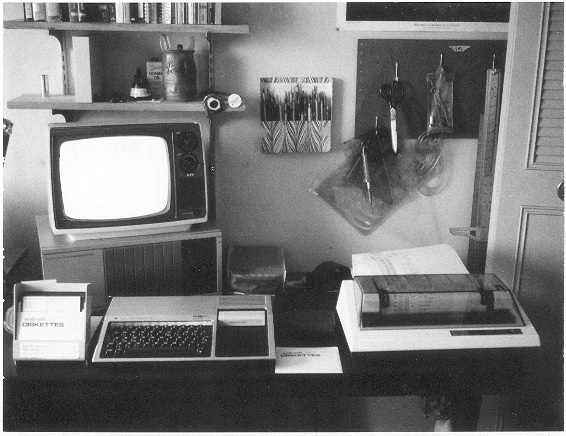My First Computer
Date:
[]
Categories:
[Blog]
Looking for something to write about, I thought it might be fun to reminisce about my first computer.

My first computer was a TI-99/4A. I got it in 1983, when the price came down to under $150 because of a price war between Commodore and TI. That’s about $485 in 2025 dollars. TI was selling them at a loss in a competition with Commodore that unfortunately they couldn’t win.
The Commodore 64 might have been a better choice. It had more capabilities out of the box, there was more third-party software and peripherals available for it, and it lasted longer in the market. But the TI-99 was an excellent computer that served me well. I used it to learn computing fundamentals and several computer languages, and set myself on the path that led to my entire working career.
I had a TI-branded tape cassette drive that was used for loading and storing programs. You could put multiple programs on a tape, but you had to manually keep track of and write down the tape position counter when you stored something so that you could find it again. It was very slow, taking maybe four or five minutes to save or load a program from the tape.
I eventually added the expansion chassis and other peripherals seen in the photo, like a dot-matrix printer and an acoustic-coupled 300 baud modem. The expansion chassis provided 32 KB of RAM, a 5.25 floppy drive, an RS-232 serial port and a parallel port. The floppy drive was a major improvement over the tape drive, taking seconds instead of minutes to save and load.
I used the modem to access Compuserve and a few other early bulletin-board systems. There was an active TI user community on Compuserve at the time.
Every brand of home computer had their own dialect of BASIC; there was TI-BASIC, Commodore BASIC, Sinclair BASIC, and many others. My first language was TI-BASIC. Later I upgraded to TI Extended BASIC, which added graphics, sound and other features.
Computer magazines and books of the day published games as listings of BASIC code, and we computer hobbyists spent hours typing the code into our computers, both to learn the language and to have a game to play. The differences between BASIC dialects made this a challenge at times.
The TI-99/4A’s CPU was the 16-bit TMS9900. At some point I bought the TI Editor and Assembler and learned the 9900’s assembly language, which I used to write a snake game. That’s the only assembler I ever learned. The 9900 had quite a different architecture from the 8086 that became a standard, but learning 9900 assembler still helped me understand CPU architectures.
The language that I most enjoyed learning was Forth. TI produced TI-Forth, but I don’t remember it; the version I used was called Wycove Forth. I really took to Forth; it had an interactive programming style that I found easy to work with. The most complete program that I wrote with it was a sprite editor.
I also had my first word processor, TI Writer. TI Writer was not a WYSIWYG word processor; it had separate operations for writing and formatting. You created text in one file, formatting instructions in a second file, and then put the two together to produce the final printed output. My wife-to-be and I used TI Writer and its mail merge feature to send her resumes to school districts all over our state, resulting in her first full-time teaching job. So the TI-99/4A helped launch both my computer career and my wife’s teaching career.
I had the computer until 1987, and then in 1988 I bought an IBM PC clone and retired the TI.
I understand that there is still quite a community of TI-99 fans, and emulators and ROM cartridge images are available. I haven’t tried out an emulator, but I’m getting nostalgic writing this post and I will probably take a look at some of them.
The TI-99/4A was a great little computer, and I guess I can say that it changed the course of my life.
TI-99 resources: